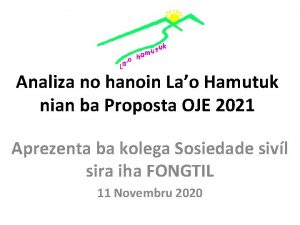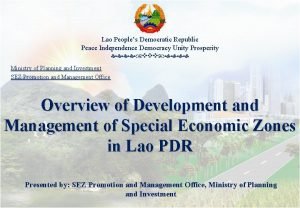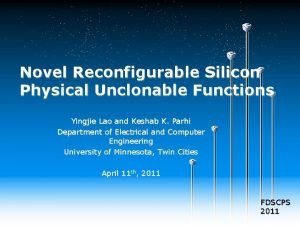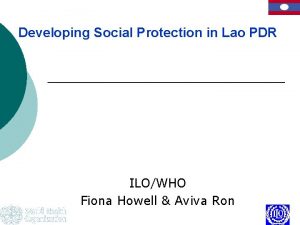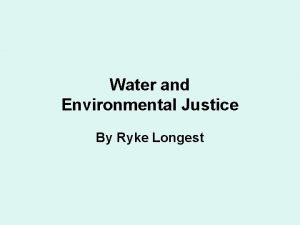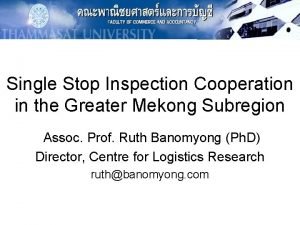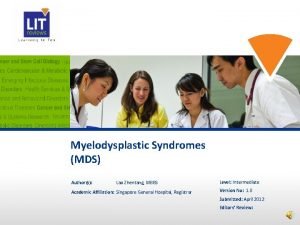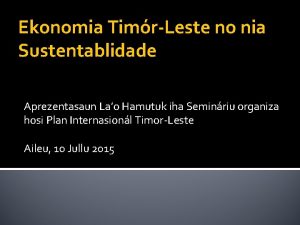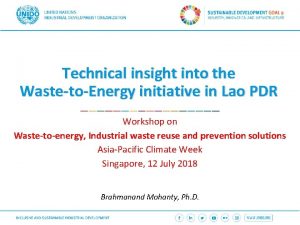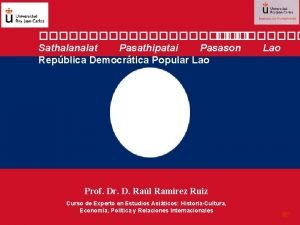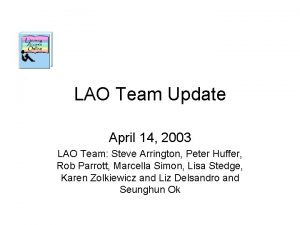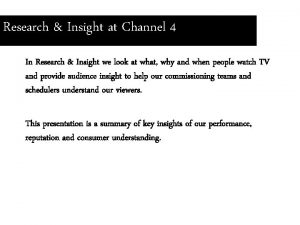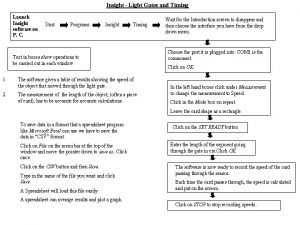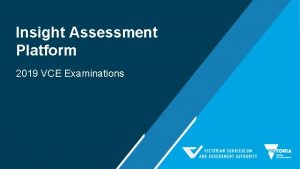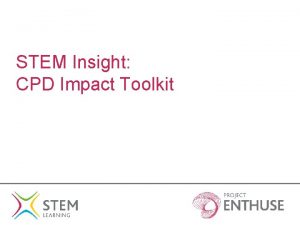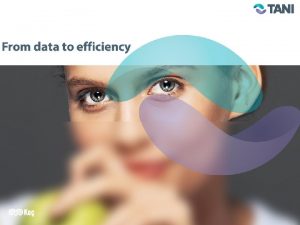Technical insight into the WastetoEnergy initiative in Lao














- Slides: 14

Technical insight into the Waste-to-Energy initiative in Lao PDR Workshop on Waste-to-energy, Industrial waste reuse and prevention solutions Asia-Pacific Climate Week Singapore, 12 July 2018 Brahmanand Mohanty, Ph. D.

Industrial waste-to-energy initiative in Lao PDR • Project Objective: To reduce GHG emission in Lao PDR’s industries by promoting the production and usage of high-quality solid biofuel for thermal energy applications Agri-residue resources in Laos can theoretically meet 238% of the primary energy use. AGRICULTURAL AND AGRO- RURAL INDUSTRIES INDUSTRIAL WASTE AND HOUSEHOLDS ADB sponsored study (2013) • Introduction of technologies, economic models and policies for: • Conversion of traditional agricultural and agro-industrial waste into modern biomass energy • Efficient utilization of modern biomass energy to avoid the import of fossil fuels, improve human health, reduce deforestation and lower greenhouse gas emissions 2

Industrial waste-to-energy initiative in Lao PDR • Situation analysis: • Traditional fuels (wood and agricultural waste): • Major source of energy, often not correctly priced, not easy to transport and use • Crude technologies for combustion: • Inefficient fuel use, low-quality product, poor air quality, affecting human health & the environment • Over-exploitation of natural resources: • Deforestation • Some industries shifting to fossil fuels: • Improve product quality and the environment but increase import dependence • Barriers / challenges: • • Lack of awareness and exposure to suitable technologies and practices Limited expertise to adopt clean technology solutions Lack of supportive policy framework for efficient use of local energy resources Lack of tools and mechanisms to develop bankable proposals 3

Industrial waste-to-energy initiative in Lao PDR • UNIDO-GEF’s response to overcome the challenges: • Propose solutions to • Convert wood and agro-industrial waste into modern energy sources (pellets) that can be easily stored, transported and used efficiently in suitably designed burners, stoves and boilers • Such solutions allow small and medium industries to • • • Reduce dependence on fossil fuels Avoid over-exploiting traditional energy sources and reduce human drudgery Carry out efficient production and improve product quality Improve the air quality in the work place and contribute to better human health Mobilize expertise to strengthen capacities of different stakeholders (producers, users, technology providers, banks and policy makers) 4

Industrial waste-to-energy initiative in Lao PDR • The above technologies are quite common in neighboring Thailand Vietnam but not yet in Laos: • • Small country with low population dispersed over a fairly large territory Easy access to traditional fuel at very low cost and averse to high first-cost Low level of industrial development and lack of support for research and innovation SMIs have poor knowledge of market to sell better quality product at higher price • UNIDO-GEF’s role: • Initiate technology demonstration through technology transfer from neighboring countries, with involvement of local stakeholders, including R&D entities • Hold sensitization seminars to showcase the technology and highlight the economic, social (job creation, gender mainstreaming) and environmental co-benefits • Support the government in creating a Biomass Technology Information and Learning Centre (BTILC) for strengthening institutional and human capacity • Provide feedback to policy makers on suitable regulatory and incentive measures 5

From agro-waste to useful energy: value chain Agriculture and Wood Sources Agro/Wood factories Pellet production plant Customers Emphasis on: - Technology support, capacity building and inclusive development - South-South cooperation - Ensure suitability of technology to the context of the country 6

Mapping of resources (waste from agro-industries) Corn cob Bagasse Phongsaly Laung namtha Bokeo ay Oudomx Bokeo Huaphan Luangphabang ay Oudomx Xaya Vientiane Capital aboury Bolikhamxay Xay Oudomx Vientiane Capital Huaphan Luang phabang Xiengkhuang Xaysomboun Vientiane boury Bolikhamxay Xaya Vientiane Xaysom boun Bolikhamxay Vientiane Capital Khammuane >80, 000 ton per year ay Xiengkhuang Xaysomboun Vientiane Bokeo Huaphan Luangphabang Xiengkhuang boury Rice Husk >150, 000 ton per year Savannakhet 100, 001 -150, 000 ton per year 60, 001 -80, 000 ton per year Saravan 20, 001 -60, 000 ton per year Sekong Khammuane Savannakhet Saravan >150, 000 ton per year Sekong 100, 001 -150, 000 ton per year Savannakhet Saravan 50, 001 -100, 000 ton per year Sekong 50, 001 -100, 000 ton per year < 50, 000 ton per year < 20, 000 ton per year Champasak Attapeu < 50, 000 ton per year Champasak 7 Attapeu

Selection of ideal site and sizing of pellet plant Source of agro-industrial waste >500 Ton per month 100 -400 Ton per month Vientiane < 100 Ton per month Factories using traditional fuel inefficiently Salt factory Objective: Minimize transportation while closing the loop (circular economy) 8

Bio-Pellet production technologies 9

Bio-Pellet consumption technologies (1) Screw feeder Flue gas stack Boiler control Fuel hopper Burner control Burner Air compressor 10

Bio-Pellet consumption technologies (2) This is in synergy with the World Bank initiative addressing a number of Sustainable Development Goals, including good health and well-being, gender equality, climate action 11

Co-benefits from a typical 2 t/h pellet plant Create 20 new jobs Avoid 10, 000 tons of coal/year Provide clean cooking for 18, 000 families Improve health of 25, 000 women & children Reduce 14, 500 tons/year of GHG emissions Protect 470 ha of forest land 12

Lessons learned to replicate best practices Low-density agro-industrial residue has a huge potential to be used as modern energy source in less developed countries Government policy should favor closing the loop at the local level Technological solutions should be dictated by inclusive industrial development goals (economic, social, energy security, environment) Awareness raising and capacity enhancement should be a constant preoccupation of national decision-makers South-South cooperation can generally make technology transfer more easily acceptable (e. g. replication in other LDCs like Cambodia) 13

Thank you for your attention



